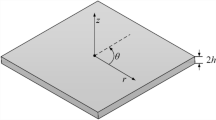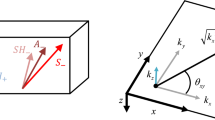Abstract
CFRP is a material widely used in a variety of industries, including aerospace, wind blade, architecture, automobile and other fields of engineering. Ultrasonic waves are widely used for condition monitoring (CM) of CFRP structures, so quantitative understanding of wave propagation on anisotropic material is essential. Conceptual ambiguities were found in previous researches and were clarified by introducing new perspective. FEM simulation was carried out for Lamb wave propagation on unidirectional CFRP plate. The wave speed of S0 mode from the simulation showed good agreement with that from experiment, which guarantees the accuracy of the simulation. For the simulation results, S0 and A0 mode wave can be separated by adding and subtracting displacements at upper and lower surface. Group velocity of S0 mode is highly affected by the propagating direction whereas A0 showed lower dependence, and this was shown in our simulation data. Also, an unexpected wave was observed in the simulation and was identified as SH0 mode.
Access provided by Autonomous University of Puebla. Download conference paper PDF
Similar content being viewed by others
Keywords
1 Introduction
Carbon Fibre Reinforced Plastic (CFRP) is a material widely used in many industries including aerospace, tanks and automobiles. It is also known to be the material used to make the blades of the wind power generator. This is because of its high strength compared to its extremely lightweight. Condition monitoring (CM) is essential to prevent failures, and ultrasonic method is one of the powerful tools for this purpose.
However, CM in CFRP is a challenge because of two reasons. Firstly, CFRP is mainly used as plates which are a dispersive medium, and wave velocity changes for different frequencies. Secondly, CFRP is anisotropic along its fibre direction, causing wave velocity to change by direction. These two obstacles make prediction of Lamb wave propagation difficult.
In the present work, we carried out both experiment and FEM simulation on Lamb wave propagation on unidirectional CFRP plate. Through this research, we showed the credibility of FEM simulation, by comparing it with our experimental results. Based on this credibility, group velocity of S0 and A0 modes was obtained from FEM simulation.
2 Conceptual Clarification of Group Velocity
When some certain conditions are applied on the solid, the wave which propagates through the solid can have energy flow which is different from phase wave direction and velocity; this is ‘group velocity’ or ‘energy velocity’. When analysing the group velocity inside the anisotropic bulk media, we usually draw slowness surface, which is the reciprocal of the phase velocity on a polar coordinate as shown in Fig. 1. Then, the perpendicular direction of certain phase direction is the group velocity direction, and the magnitude of the group velocity is
Direction of the group velocity derived by the slowness surface [1]
where \(c_{\text{g}}\) is group velocity, \(c_{\text{p}}\) is phase velocity, and \(\theta\) is skewed angle. In this case, the group velocity is bigger than phase velocity.
In the other hand, the Lamb wave dispersion curves in isotropic media show that the phase velocity is generally bigger than the group velocity. In this case, group velocity is defined by
in one dimension. Because the magnitudes of the phase velocity and group velocity are different in the above-stated cases; the group velocity in an anisotropic plate is hard to derive. In fact, asymptotic wavefront (the set of group velocity of each direction) can be obtained by getting group velocity from certain direction and modifying the direction by slowless surface [2].
However, the definition of group velocity in multi-dimension space is
where \(\omega\) is the angular frequency, and k is the wave number [3]. This definition includes that the direction of the group velocity is perpendicular to the slowless surface, but the value can be different with the \(\partial \omega /\partial k\) in certain direction. Therefore, group velocity is given by gradient.
From the phase velocity dispersion curve, we can draw \(\omega\) versus k graph for each direction and combine them on two-dimensional wave vector domain, kx and ky. Then, the group velocity of certain phase velocity direction and angular frequency is the gradient \(\nabla_{k} \omega\) of that point. When the point on the three-dimensional graph is not continuous,
then solve this simultaneous equation about each partial derivatives. a, b and c, d are the x and y components of two different small vector \(\Delta \vec{k}\) from the point we are investigating. This means that we check the difference of angular velocity between the investigating point and two other adjusting points. \(v_{x} ,v_{y}\) are solution of the equation, and they are partial derivatives. \(\omega_{ab} , \omega_{cd}\) is angular frequency of each point, and \((v_{x} ,v_{y} )\) is the group velocity.
3 Methodology
3D FEM simulation that completely matched the experimental conditions was devised to get a theoretical account of the wave velocity of the Lamb wave on unidirectional plate. The thickness of the plate, wave frequency and cycle were same as the experimental conditions. The unidirection CFRP material was modelled by entering the stiffness tensor of the CFRP plate.
A benefit of using the FEM simulation is that it allows us to separate the symmetry mode and antisymmetry mode. In experimental data analysis, we are only able to find the velocity of S0 mode, which is the fastest mode, since we only can track the velocity of the wave that comes first in the oscilloscope reading. Others are ambiguous since the waves interfere. However, by using the characteristic of symmetry and antisymmetry, for FEM simulation results, we can add or subtract the data from the top and bottom of the plate of the same point on CFRP plate. By this method, we can get a more reliable data analysis method, by being able to separate the two modes.
In our experiment, we prepared an unidirectional CFRP whose thickness is 1.4 mm and used 1 MHz oscilloscope, wave generator and 1.0 MHz transducers to generate, receive and record the wave data. The CFRP plate was eight-ply ([0]8) with thickness of 1.4 mm. A five-cycle tone burst sine wave signal with 0.36 MHz frequency was used as an input signal to the plate. Experiment was also carried out for fd value of 0.50 MHz·mm in order to only allow S0 and A0 mode to be observed.
The distance and angle between the receiver and the source were varied. Distance from the source was from 3 to 12 cm with 1 cm interval, and the direction of placement was from 0° to 90°, with five intervals from 0° to 30° and 10° interval from 30° to 90°. The 0° line represented the fibre direction (x-axis). Transducers and oscilloscope were used to collect the signals.
4 Results and Discussion
Figure 2 shows typical waveforms along the radial lines, from 3 to 12 cm. The waveforms were shifted with increasing propagation distance, and the group velocity of the Lamb wave can be determined. For simulation, we could get more accurate result by using the symmetric and antisymmetric property of the Lamb wave. By adding and subtracting the out-of-plane displacements obtained at the upper and lower surfaces, S0 and A0 mode can be obtained as shown in Fig. 3.
Even though only group velocity of S0 mode was obtained through experiment, both those of S0 and A0 modes were obtained through simulation. Video snapshot of the experiment results is shown in Fig. 4. For S0 mode, the experimental results were compared with the simulation results and shown in Fig. 5a, which showed a very good agreement. From this, the credibility of the FEM simulation is confirmed in determination of the group velocity of the Lamb wave. This allows us to reliably obtain the group velocity of the A0 mode from the simulation results as shown in Fig. 5b. It is clearly shown that S0 mode was seen to have very high dependence for direction, while A0 had much smaller dependence.
Video snapshot of vibrational displacement in a x-axis direction, b y-axis direction and c z-axis direction (out-of-plane). The snapshot shows the image at time t = 0.0247 ms. The most dominant oval wave is the A0 mode, whereas the straight waveform parallel to x-axis is S0 mode. It is also noted that S0 mode is much weaker in z-direction displacement, which is expected, since S0 mode consists of in-plane displacements
Unexpected wave was found in the FEM simulation video, with its vibration displacement dominantly on y-direction (90° direction). Figure 4b shows the video snapshot of y-displacement. This wave was seen to be nearly isotropic, with its wavefront being almost in circular shape. From the vibrational direction of the wave and the almost isotropic property of the wave velocity, we deduced that this wave is the shear horizontal mode. Further verification of the wave mode was done by comparing its velocity to theoretical SH mode velocity, and they were seen to be similar, around 2000 m/s. It implies that in-plane displacement is also generated for the normal excitation [4].
5 Conclusion
In order to obtain quantitative information of wave propagation in CFRP plate, both experiment and 3D FEM simulation have been carried out. The simulation and experimental results showed good agreement with each other, which proves that the FEM simulation results are credible. S0 and A0 mode wave can be separated by adding and subtracting displacements at upper and lower surface. It is shown that group velocity of S0 mode is highly affected by the propagating direction whereas A0 showed lower dependence. An unexpected wave was also observed in the simulation and was identified as SH0 mode.
References
Carcione JM (2015) Anisotropic elastic media. In: Wave fields in real media, 3rd edn. Elsevier Science, Amsterdam, pp 1–62
Rhee S-H, Lee J-K, Lee J-J (2007) The group velocity variation of Lamb wave in fiber reinforced composite plate. Ultrasonics 47:55–63
Auld BA (1973) Group velocity and energy velocity. In: Acoustic fields and waves in solid, vol. 2. Interscience, Geneva, p 202
Kim YH, Song S-J, Lee JK, Kim HC (2003) Transverse-wave modes in the pulse-echo signal of a normal-beam longitudinal-wave mode transducer. J Korean Phys Soc 42:111–117
Acknowledgements
This work was supported by the Korea Science Academy of KAIST with funds from the Ministry of Science, ICT and Future Planning. Thanks to Dr. Jeong-Ki Lee for his valuable comments.
Author information
Authors and Affiliations
Corresponding author
Editor information
Editors and Affiliations
Rights and permissions
Copyright information
© 2021 Springer Nature Singapore Pte Ltd.
About this paper
Cite this paper
Kim, S., Song, J., Kim, S., Cho, Y., Kim, Y.H. (2021). Lamb Wave Propagation of S0 and A0 Modes in Unidirectional CFRP Plate for Condition Monitoring: Comparison of FEM Simulation with Experiments. In: Gelman, L., Martin, N., Malcolm, A.A., (Edmund) Liew, C.K. (eds) Advances in Condition Monitoring and Structural Health Monitoring. Lecture Notes in Mechanical Engineering. Springer, Singapore. https://doi.org/10.1007/978-981-15-9199-0_72
Download citation
DOI: https://doi.org/10.1007/978-981-15-9199-0_72
Published:
Publisher Name: Springer, Singapore
Print ISBN: 978-981-15-9198-3
Online ISBN: 978-981-15-9199-0
eBook Packages: EngineeringEngineering (R0)









